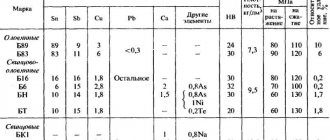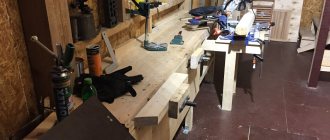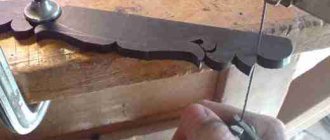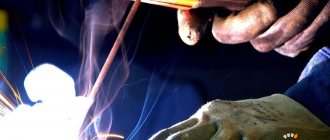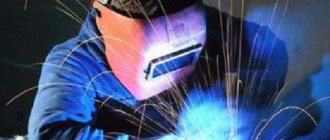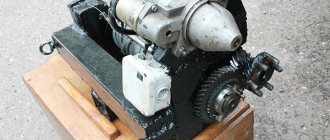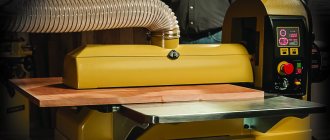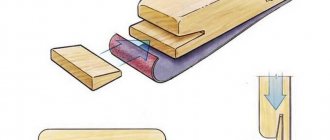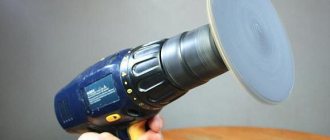Is it possible to make money using your lathe? Business Experience
I'll tell you right away. You can earn even a couple of million. The main thing is to build a strategy correctly.
Place.
It would be nice if this was your garage, from 24 square meters. With stove heating. Electricity supply minimum 15 kW. This is the starting peak of the launch on the 16k20 machine. power 12 kW. On IZHA and 1a616 the power will be less than 5-7 kW will be enough. I don't recommend a smaller machine. Concrete base for the machine. We are only considering the option with vibration supports. Don't concrete. In the process of expanding the business, you will move the machines precisely. Over time, a milling machine will appear. and maybe something else. The distance from the house is preferably as close as possible. Ideally, a private house within the city. And on the site there is a brick garage. At the beginning there is not much work, why would you disappear in the garage all day long? Mechanical machines are unpretentious to weather conditions. Even a minus won't hurt them. As long as the lubricant doesn't freeze. For the future, consider having year-round access to the place. The snow was cleared, it won't float away in the spring.
The convenience of delivery of materials depends on the place you have and choose, and the garage itself will be your second home for a year.
2 Equipment.
The machine will ideally be 1m63, but it is bulky, but it will be possible to sharpen drums on a super MAZ. The most ideal machine in terms of size and capabilities is 16k25, 1k625 or an equivalent. With a 250 chuck and the ability to clamp diameters from 0 to 500 mm. The choice of machine must be approached carefully. A machine in more or less normal condition will cost at least 100 thousand. Don’t try to look for equipment in collective farms and repair shops; machines have already been sent there after complete repairs. There are no normal people in this sector.
Consider the option of going bankrupt factories. At auctions. This path is more difficult, but the equipment is first-hand. The next step is outbidding. We are looking for them on Avito, Directlot. Yes, yes, there are outbids here too, they buy from auctions. It will be more expensive. The machine is sold under a purchase and sale agreement, which can be written by hand with the provision of passport data, and the price. This will also be a document for transportation.
The condition of the machine will depend on luck at the auction or on the budget. It is better to see the machine in person. I would also like to sharpen something and listen to the operating modes. Development of the bed, shallow stripes are allowed, do not take with obvious ditches. If you don't have a cartridge, buy it separately.
3 Commissioning, tool materials.
After purchase, you need to bring the machine. I took a 7-ton manipulator based on Kamaz. But for 16k20, even a small 5 ton truck is enough to drag it into the garage. We roll it through the pipes. The more cabinets, the more pipes. I pulled the tailstock forward. I placed it on the edge of the garage floor with the hook resting against the visor. Then we hook it to the headstock through the engine compartment. Long sling. Lifting it up, we roll into the garage. A smoother floor will roll faster). A couple of 3-5 ton jacks to remove from the pipes. I positioned the back of the machine towards the gate, slightly diagonally. Easier to maintain. Sweep away the shavings. It's uncomfortable against the wall. Well, you can also put it the other way around when you stand with your back to the wall, but no less than a meter from the longitudinal handle to the wall. on TB. Connected with copper stranded. To the machine on the wall. The machine turned off every time at the end of the work shift. Just in case.
I got the tools at metal receiving sites, you can also buy them through Avito or Directlot. You will need a couple of drills. You can also squander it. I bought the dies for work. I bought cutters for 70 rubles on Avito and sharpened them at the factory while I was still working. Then I bought a sharpening machine with 200mm wheels. white and green.
I bought materials from a ferrous metal shop if the parts were not responsible. But good steels can also be found there by markings. Study the color markings of steels. Tested material at metal warehouses, expensive, they will cut as much as necessary, include parts in the price.
4 Searching for clients for turning work.
First, submit advertisements to all bulletin boards in your city. You need to develop a base, earn trust, earn a reputation. Your first clients are car repair shops. Go around, call, tell us what you can do. Sharpen brake discs, adapters, mandrels, special tools. Find out the price of services in the city if there are still turners.
Determine the cost of your hour of work. Never use hinges, they cost pennies. They are incredibly cheap at home stores.
So, if you have one lathe, look for milling and heat treatment specialists at factories where you can skip the hacks. What milling machine operator doesn’t want to earn extra money? Calculate your work and third-party work, tell the price to the client. Don't allow mistakes on your part.
Lathe shop as a business
A machine operator can start his own business by opening a turning shop. It is enough to place a tabletop machine in the garage or rent a container at the market. It is more difficult to find orders for a full load of equipment. In the turning business you will need sharpening and drilling machines. The presence of welding will significantly expand the list of services. Nowadays, a lot of small work is done on a metal lathe. We need parts for repairing household appliances, bicycles, cars and other individual products.
What can be made on a CNC milling machine
Modern woodworking machines are multifunctional. You can not only turn a part on them in full compliance with the dimensions, but also make an engraving and cut out a relief. Using a machine, you can make carvings that resemble wooden lace from sheet materials. There is no human factor in the operation of the machine; the drawings stored in the computer will be reproduced with high accuracy.
A lot depends on the choice of quality equipment. When the master is confident that the equipment works 24/7 and produces high-quality products, then no competition is scary and you can safely scale the business.
Choosing a location for a turning workshop
A well-located turning workshop will be provided with orders without high advertising costs. If potential customers are nearby or constantly pass by, they will find the workshop themselves. The most successful location for the workshop would be:
- in a garage cooperative;
- next to a busy road;
- near a construction supermarket;
- on the market territory.
The main customers at first will be technicians involved in the repair of various equipment, installation of heating systems, and car enthusiasts. While searching for spare parts, they will find a lathe shop located in a prominent location.
In villages with a small population, orders will have to be sought externally and metal imported from afar for work. Transportation costs will eat up most of the profits. In remote villages and on the outskirts of large cities, you can open workshops if the business is expanding, there are constant orders in batches, and the existing equipment cannot cope with the load. Renting premises on the outskirts will cost less for a branch. Local workers do not aspire to Moscow-level salaries, but recruiting personnel will be more difficult.
A large space for a developing business should not be rented; for the first time, a garage or container will do.
8–10 sq/m is enough, on which there will be a compact layout:
- a lathe is the basis of the business;
- auxiliary equipment;
- tool storage location;
- area for blanks and rolled products;
- table or shelf with finished products;
- washbasin with water;
- fire extinguisher.
When choosing a location for a workshop, you should pay attention to the presence of:
- electricity;
- water supply and ebb;
- availability of a bathroom.
It is difficult to install a toilet in a small room. It’s easier to locate your business in a market or next to a supermarket. In this case, a public toilet will be within easy reach.
During cold weather, it is necessary to equip the room with heating and ensure the air temperature established by sanitary standards. This possibility must be foreseen in advance when choosing business premises.
When locating a turning workshop in a permanent building, you will need to equip:
- separate entrance;
- a major partition from the rest of the room;
- bathroom with water and low tide;
- wash basin;
- ventilation;
- fire shield.
Turning workshop. Electrification of the premises
Comfort and safety become safe with proper lighting, implementation of earth protection measures, zeroed tires, equipment, machines, tools. The turning workshop must have at least 2 - 3 types of lamps, housings, reflectors, metal parts are grounded.
- 1 lamp is placed so that the light is diffused towards the ceiling. It is placed this way, illuminating 9999% of the workshop area.
- 2 lantern is placed with a predominance of directional light at the workplace.
- 3 light sources are made natural: a window, an open door.
- Use an additional lighting device. The best solution is to use LED lamps in the lamp.
More than 70% of the area of the lathe workshop should be used to draw the shadow further from the workplace with each lighting fixture. LED lamps consume less electricity and distribute heat. They provide a normal glow and safety for the eyes. The electrification of the premises is combined with the placement of the maximum number of 3-pole 220 V sockets, 3-phase sockets with a grounding bus. Calculation of consumption of sockets + machines is performed with a utilization factor of 0.26 - 0.66. Large machines consume maximum power, so the conductor cross-section is selected based on the current load, in 2-insulation. 1 emergency lighting lamp from an uninterruptible power supply is installed in the room for 3-5 hours.
Jpeg
Equipment selection
In an enterprise of any size, regardless of the product being manufactured, lathes are the busiest and most in demand. Most of the cutting work is done on them. You should start your small business by purchasing a tabletop machine. Small equipment for a turning shop has significant advantages:
- connected to the household power supply network;
- do not require a special foundation for installation;
- space under the table and drawers can be used.
The equipment of a turning shop cannot be limited to units of the same type. A sharpening machine for cutters, drills and other tools is a must. A set of circles is purchased for it, taking into account the work performed on it. In addition to tools for the machine, it can be used to sharpen garden tools, knives and axes.
Tools for turning business
A machining business is impossible without cutting tools. Need to purchase:
- set of cutters;
- carbide plates;
- drill;
- taps and dies.
A place must be provided for storing tools. It should be near the lathe. Equipment is also stored there. A tabletop lathe allows you to use the cabinets and drawers of the table on which it stands.
Tools are bought in large quantities from hardware vendors on the market. Many old workers sell tools made in the USSR. When purchasing, you should choose cutting, scoring and through cutters.
Drills are useful in two types: with a diameter that is a multiple of an integer mm, and for threading. In addition to dies and taps for metric threads, you will need a tool for cutting pipe threads near the hardware store.
Basic universal equipment is sold complete with the machine. Special devices are made and purchased as needed when needed for work.
Optional equipment
The next purchase for your lathe business should be a benchtop drill press. It will not have a full load, but will significantly expand the list of manufactured parts. Having received a machined pulley, the customer will not look for where to make a hole for the mounting bolt.
A turning and milling business does not require a large area of premises. Even desktop equipment with a 230 W power supply will allow you to make keyways, splines, and selections. On shafts they are necessary for fastening and transmitting torque.
The milling unit will allow you to make parts with a complete configuration, grind hexagons on bolts and nuts, when manufacturing from round bars, make crackers and dowels.
To work, you will need cutters of different types and replaceable carbide inserts. From the equipment, adapter cones for the spindle, fasteners.
Equipment for business expansion
It is necessary to expand production using floor-mounted lathes such as VT and TVSh. Large units are not needed because they:
- expensive;
- take up a lot of space;
- require a foundation for installation;
- consume large amounts of energy;
- will not be fully loaded.
Large parts are made in production. The population and small entrepreneurs - potential customers - are interested in small things.
When expanding your turning business, you need to focus on the specifics of the region and what orders you receive most often. Having regular customers who regularly need the same parts, it is good to purchase a CNC turning and milling machine. It will completely replace a whole range of machines and will be justified in batches of 20 pieces or more.
Purchasing a welding machine transforms a business from small to large. Such production requires a spacious room with a fenced welding area, several lathes and a cable supply with a voltage of 380 W. To effectively operate the equipment, it is necessary to hire several turners and workers of other specialties.
To operate, the welding machine requires a step-down transformer that changes operating modes. From the tool you will need electrodes of different brands. To clean up welding and finished seams, you need a grinder and circles.
How much does the machine and consumables cost?
The main equipment for doing business is a numerically controlled milling machine. Manufacturers, including the MULTICUT company, sell a large number of models that differ in functionality and power output. When choosing a machine, you should be guided by the list of services that your company will provide and financial capabilities.
Based on cost, CNC machines are divided into 3 categories:
- Budget equipment. This type includes, for example, mini CNC machines for small businesses. They have low power and positioning accuracy, and a small surface to work with. The cost of such milling installations is about 100,000 rubles. They are suitable for use in small industries and are used for processing wood and certain types of metals. Such equipment is capable of performing a limited number of operations.
- Equipment of the middle price category. Such machines are valued at 500,000 rubles or more. Their power level allows for linear production of different products or work with several types of metals on a personal order. The equipment can also be used for decorative surface treatment and the production of three-dimensional letters and images. Machines in this category are characterized by an ideal balance between cost and functionality and are suitable for small businesses.
- Expensive industrial equipment. It is distinguished by high power and wide functional properties. Its cost ranges from 1.5 million rubles or more. Such equipment is capable of performing processing operations on almost all materials and 3D modeling of workpieces.
Milling installations should be provided with the required components and spare parts. The most important thing is to have all the necessary cutters, as well as spare ones. In total, a set of cutters, drills and engravers for milling various materials will cost approximately 50,000 rubles.
Various metals and wood act as consumables. Sometimes clients provide blanks for work. In other cases, raw materials should be purchased independently, and their cost is included in the final price of the product.
Fixed costs include the salaries of operators who maintain the equipment. Main requirements for operators:
- ability to operate equipment,
- experience,
- high qualification.
Administrative work (keeping records, searching for customers, selling products) can be taken over by the business owner at first to save money.
Among other things, you need to pay monthly for electricity. Spending on this resource will range from 15,000 rubles or more. In general, running this type of business activity usually costs about 40,000 rubles per month.
In-demand products
When starting your turning business, you need to find out which turning products are in greatest demand. Starting to produce batches of parts for sale means risking being left with unsold products. Everything that is made in large quantities is produced by large enterprises.
At the initial stage of business on a lathe, customers will tell you what to produce. You need to tune in to the individual production of parts for repairing cars and household appliances.
Gradually, people will learn about the opportunity to turn a shaft or other part for repair at an affordable price in a lathe shop nearby. Many people have equipment at home for which they have stopped producing spare parts, but it is working and it is a pity to throw it away because of a broken axle or other part. Similarly, a bolt or washer for a car can be bought at a car dealership, but the price is steep.
Large enterprises are reluctant to take on small orders from outside. A calculation is made for workshop costs:
- hourly cost of machine operation;
- payment for electricity;
- wages of the main worker;
- wages of auxiliary workshop workers;
- depreciation charges for equipment.
Typically, large enterprises have DIP200 and even larger turning units. They consume a lot of electricity, regardless of the size of the part. The machine operator works according to the technology and drawing developed by the engineering staff of the enterprise. Additional costs exceed workshop costs by 3-5 times. The result is astronomical prices for the manufacture of parts.
When developing business ideas, you should also take into account customers with small batches of parts. Builders, auto mechanics, furniture makers and other specialists will appear quite quickly. They will need to make adapters for heating pipes, cut threads and bore nuts. Furniture makers who are accustomed to working with wood cannot grind the studs and make nuts for them themselves. If the cost of production from a turner working nearby is lower than purchased materials, they will willingly go to a small workshop.
It is difficult to predict which parts will be in demand. Each city, and even microdistrict, has its own needs for small things made on a lathe.
How to make money producing wooden accessories
In 2012, a student at Khakassia State University, Konstantin Slatvitsky, decided for himself that he absolutely did not want to become an office clerk, of which there are hundreds of thousands in Russia. And, after much thought, I decided to open my own workshop of wooden gifts and accessories. He had no experience in this area, nor any skills in working with wood. However, there was no equipment either. However, in three years he managed to create a profitable production. The founder of the Slatwicki brand, Konstantin Slatvitsky, told the Biz360.ru portal about how the workshop of wooden accessories is organized.
Dossier
Konstantin Slatvitsky
, 26 years old, entrepreneur from Abakan, founder of a workshop for the production of wooden accessories. Graduated from Khakass State University with a degree in State Municipal Administration. The Slatwicki brand produces wooden watches, bow ties, glasses, card holders, document covers and other accessories.
Learned from YouTube
When I got the idea to produce wooden accessories, the first thing I encountered was a lack of information about how to work with wood correctly. Even when we bought machines, the most that came with them was instructions. And that one is in English and Chinese. We still have only one person on our team with a degree in artistic woodworking. Everyone else is managers, media specialists, there is even a seamstress.
Therefore, we all had to dig for information, read a lot, learn by trial and error. We couldn’t sign up for some courses - they were held mainly in Moscow and St. Petersburg, and they cost from 35 thousand rubles. Plus it was necessary to live there on something. In addition, we understood that they would not teach us much there, but would only show us the basics. Otherwise, you still need to gain experience.
We read the instructions for the machines, looked for bits and pieces of other people’s experience, and watched video tutorials on YouTube. It got to the point where they took a “freeze frame”, noticed what kind of glue or tool the master was using, and went to the store for the same
So, by making mistakes and trying, we learned to use all this equipment within a year - and in 2013 we began making various letters, inscriptions, and wall accessories. At first they sold it not in our region, because in Siberia they looked at us like fools: “Why make something out of wood, there is plenty of it around and without processing.” Therefore, the first products were sold to Moscow and St. Petersburg.
In 2015, they decided that it was necessary to produce more standardized products. The development of accessories began: costume jewelry, bow ties, and, in priority, watches and glasses. By November 2015, we had our first wooden wristwatch ready. We presented our project on the crowdfunding platform. The audience liked the development: we tested the idea and got clients. Then they collected about 300 thousand rubles, which made it possible to launch mass production.
1.8 million rubles were invested in machines
My starting capital was 150 thousand rubles. I borrowed about 80 thousand from my mother and grandmother - they took out a loan, since no one would give it to me, a student. In 2013, we won a grant at a business ideas competition and received 300,000 rubles, making it onto the list of 40 winners.
I spent the starting capital on the first machine with numerical control. In Russia it then cost 380 thousand rubles. I contacted the manufacturing plant, where the same equipment was sold for 153 thousand rubles. When I realized how much the resellers were charging, my hair stood on end.
We also needed milling and lathes with clock control. You set all the parameters, and then the computer controls. This gives maximum accuracy. That is, you can draw for a long time once, select clear parameters using trial and error, and then just press the button.
Grinding machines were also needed to bring the products to the required condition. Over the entire period, about 1 million 800 thousand rubles have been invested in equipment. This is not much for such a production, but we still have enough machines and equipment.
To make all the accessories, we use the same machines and wood, just a slightly different processing method, and you need to set different parameters on the machines.
“The glasses for Siberians are larger - their faces are wider”
The main thing in watch production is the base, the case. It cannot be changed. This is not just a “round piece” when it comes to watches – it is made in several layers so that the product is not fragile. All have the same body. And the color of the hands, dial, fittings and strap can be selected to suit your taste. If we take a typical product, then, for example, one pair of hours takes about 40 hours of work.
As for the glasses. We have two main sizes: for Siberians (since people beyond the Urals have larger faces) and for other Russians. Accordingly, they are standard, and everything else can be customized. We insert lenses into optics so that they do not harm vision. Otherwise, clock-controlled machines do everything you ask - the main thing is to draw correctly.
Some prices for Slatwicki brand products: watches - 4,000 rubles, glasses - 4,000 rubles, cardholders - 600 rubles, document covers - 900-1100 rubles, notepads and sketchbooks - 550-1000 rubles.
Now we produce watches, glasses, notepads, holders, cufflinks, bow ties, covers for car documents and some other accessories. In principle, we can make anything to order. That's why we often receive corporate orders for souvenirs or some unique items. For example, now the corporate portfolio of orders is full until November, and then orders will appear for the New Year.
We make mainly from oak and ash. About four years ago there was a problem with trees in the Russian Federation. Now we order a lot from the European part of Russia, but materials such as wenge, cocobo, and American walnut come from abroad. We order them through warehouses in Moscow. We have two to three proven suppliers.
It is very difficult to raise funds for equipment through crowdfunding
We were one of the first in Siberia to begin submitting projects to crowdfunding platforms. The first two endeavors failed, but we learned a valuable lesson and experience. And henceforth we tried to take into account the mistakes. After this, three projects were successful.
All proceeds received through , go towards large wholesale purchases. For example, to launch a series of watches, it is not enough to buy 100–200 sets of components. Take at least a few thousand. With this option, the cost price will allow you to keep the price tag at an acceptable level.
For people living in Siberia and the Urals, 4,000 rubles per watch is a significant amount. And we simply cannot raise the price
Of course, it would be nice to raise money for new equipment. But in order to launch a crowdfunding project for equipment, it is necessary to raise the bar to 2–3 million. This amount is very difficult to collect; not all interested parties will believe that this is possible and will not transfer their contribution.
Team
We have two divisions in our company: one is responsible for mass production, the other for more precise production, in particular, for watches.
For the first year and a half, we worked together with Oksana, my girlfriend, who later became my wife. She helped me a lot, several times it was only thanks to her that the project did not close. When our hands were no longer enough, we hired the first two employees.
In 2021, we became seven people: Oksana and I, a designer, a content manager, two people in production, an artist who knows how to work with wood. I am engaged in advanced production - searching for materials, purchasing equipment. My wife is in charge of practical planning.
Sales and promotion
The bulk of the products are sold to Moscow and St. Petersburg. We ship to companies, they resell to private customers - most customers have their own online stores and brick-and-mortar locations. We also sell through Vkontakte - individual orders come from there. We are currently developing it, but we understand that its development and promotion is quite expensive, so we are not in too much of a hurry.
Initially, promotion was only through social networks. Since 2014, we have been doing well through crowdfunding. In my opinion, this is a great way for beginners to introduce themselves. We also tried to work through Yandex.Direct, but it so happened that one real client cost us 1,500–2,500 rubles. This is expensive for us; this option is not suitable for small production.
What's next
Our project was fully paid for by mid-2015. For the first one and a half to two years we constantly invested in the business. At first there was a slight “minus”, then we reached “zero”, and now we are a profitable enterprise. As it turned out, in order for this activity to start making a profit, you need to seriously invest for two to three years.
Our priority in further development will be the production of glasses and watches, these are the most popular products. There will be another development, but this is still a surprise. We need more intensive development of our online store; this is another point of growth for our business.
Tips for Beginners
A turner can earn money on his own machine, producing in-demand parts. These are mainly simple-shaped spare parts for cars, washing machines, and vacuum cleaners. Fittings for plumbing and connecting washing equipment may be in demand.
The amount of earnings on a lathe depends on the number of orders and ability to work. Advertising and good customer reviews help implement any business plan. It is not enough to hang invitations on poles and post an advertisement on the Internet. You need to attract people with your work. Make any order, even the cheapest one, efficiently and quickly. A satisfied client will definitely tell his friends about the workshop.
Having cheated once, the entrepreneur receives anti-advertising. It spreads faster and is more effective.
The turning workshop in the business plan should include measures to improve customer service conditions and improve the quality of work.
When hiring personnel for a workshop, an entrepreneur must pay attention to the level of the machine operator, his physical condition, and work experience.
Business: how to open a turning workshop
If you have extensive experience in turning, then you can seriously think about opening your own turning workshop. You can work “for someone else”, but only in order to put together start-up capital to buy equipment.
Turning business is a very promising occupation, because there is no big competition here. Of course, there are large factories and companies that engage in metal processing, but they are not your competitors because they only accept large orders. There are a lot of small customers who will be your clients.
How to work on a lathe, what can be done on it?
Lathes, the basis for most small and medium-sized industries, are popular all over the world due to their high efficiency in processing workpieces and producing a variety of parts.
Machine tools have a fairly large number of varieties, determined by their functional tasks, and we will introduce the reader to all this diversity in our material.
Types of turning equipment
Types of machines are divided depending on the following parameters:
- purpose of the machine;
- the accuracy of the work he performs;
- its mass;
- the maximum length and diameter of the part that can be processed on the machine, as well as its position in relation to the processing tool installed in the machine.
In fact, it is possible to divide machines into woodworking and metalworking, and then allocate their own subgroups in each group, depending on the specifics of the equipment, focused on performing specific tasks assigned to the machines.
Woodwork
Woodworking machines usually have a slightly smaller size and power compared to their “colleagues” working on metal; in addition, they do not require a coolant supply system, since working with wood produces significantly less stress. There are quite a large number of varieties of machines for woodworking, let’s look at them in more detail.
How to use?
Before giving a brief excursion into the specifics of using lathes, it is imperative to remind you to follow the safety rules when working with this equipment:
- The worker’s clothing and shoes must cover the entire body, leaving only the hands, neck and head exposed; clothing ideally should not be tight or loose - this set of measures will protect both from small chips flying during work and from serious injuries that can occur when clothing is pulled into the moving elements of the machine.
- You must wear safety glasses and stand on a wooden surface to avoid electric shock while operating the equipment.
- It is absolutely necessary to always use a machine protective cover that will cover the rotation zone of the fixed part.
Lathes, for the most part, are quite easy to learn, so both under the guidance of experienced craftsmen and with the help of training videos on the Internet, you can learn the basics of their use and take your first steps in this area.
Primitively, the principle of operation on a machine (for example, we take a screw-cutting lathe) looks like this:
- the worker stands in front of the machine;
- places the workpiece between the two ends of the drive shaft;
- turns on the machine;
- moves the cutter smoothly and slowly while performing processing;
- turns off the machine upon completion of work.
More detailed instructions, of course, are better to receive under the supervision of experienced colleagues, since even videos are not yet able to answer the questions asked that arise while working on the machines.
Product description and manufacturing diagram
When starting to manufacture wooden balusters, you need to familiarize yourself with their design features, including:
- a base fixed to the floor, threshold, step using a baluster (rail);
- decorated central part;
- support for railings or handrails.
Simple instructions on how to make a baluster in a small production workshop are as follows:
- The choice of material for supports depends on several factors: the material of the main structure, requirements for the appearance of the product and the method of fastening.
- Determining the size of balusters. It should be remembered that when installing supports, their height decreases slightly. Therefore, for railings with a height of 90 cm, the best option would be posts whose length is 85 cm.
- A regular edged board is cut into square blanks of the same size. A machine equipped with circular saws processes such elements easily and quickly.
- Calibration will help give the product an even and smooth appearance.
- The workpiece is cut on a cross-cutting machine: damaged areas, chips and other defects are removed.
- Using a lathe, the center of the product, the base and the support are formed.
- Once the baluster has received the desired shape, you can begin decorative work: carving, applying paint, varnish or impregnation.
Workshops whose activities include the manufacture and sale of wooden balusters for stairs often accept turnkey orders. That is, the specialist performs the full cycle of work, from measurements to installation. In this case, the shape of the baluster is developed jointly with the customer and executed according to the approved sketch.
What can you do with it?
A lathe in skillful hands and with the necessary materials for the job is an extremely effective tool for the manufacture of metal or wooden products, and this can include both high-precision parts for other equipment and a variety of handicrafts for home or leisure.
Wood products
You can make wood products both “for the home, for the family” and for sale. In the latter case, the things made have a magical prefix in their name “made individually,” which in our era of globalization of all processes has considerable weight in the eyes of many potential buyers.
You can make furniture elements for its subsequent assembly (we think everyone remembers school stools made and assembled in labor lessons), tool handles, medium and small decor - the basis for wall clocks, vases, figurines of creatures, a popular type of machine-made products are chess, checkers, backgammon.
Metal crafts
Lathes for metalworking are usually not associated with crafts, because with their help, a lot of enterprises and individual craftsmen work on the manufacture of nuts and bolts, bushings and couplings, rings and shafts for various purposes, the maximum that a person who does not have information can imagine is this boring some parts during repairs and similar actions.
However, the range of tasks performed is not limited to work. Metal crafts can be made by both an experienced worker and a novice trainee; most often these are figurines or individual decorative elements: balls and keychains, cubes and entire models (for example, cars).
In conclusion, I would like to note the following: the world of lathes, with all its size and diversity, is available to everyone who wants to try themselves on this path. Moreover, now, with the active proliferation of CNC devices, a small lathe can be installed even at home, and after taking courses on its use, with time and growing experience, you can become one of those who can turn a piece of material into a real masterpiece, be it it is intended for work or leisure.
Introduction
Despite the fact that CNC milling machines have been a common tool for solving a huge number of production problems for decades, not everyone fully understands their versatility and real capabilities. Cause?
Divided into:
a) highly specialized machining centers for metalworking, machining centers for serial production of furniture, 5-axis for the manufacture of large-sized molds, including those with a spindle mounted on a robotic manipulator (so-called milling robots).
Machining center HAAS VF 3ss
CNC machining center. CNC Processing Center.
CNC 5 axes. CNC 5 axis. Robot for milling work.
b) The middle segment of conventional 3- and 4-axis processing machines (which can solve the problems of the two above groups, but with lower productivity) mainly used for work in the advertising, production, construction and finishing sectors, including stone processing and small-scale or custom production, including exclusive furniture with 3D elements.
CNC milling machine
c) Small-sized 3,4,5-axis machines for the jewelry and dental prosthetic industries (they can be either very expensive or not very expensive), inexpensive options are often used in small or home workshops.
5 axis milling machines for dental prosthetics
d) Hobby ones, made either “on the knees” from plywood, or in the factory from machine-made profiles, steel tubing or aluminum plates. Wide range of uses from cutting veneer to milling aluminum. Due to their low cost, they are purchased by novice entrepreneurs or craftsmen for home creativity.
Hobby CNC Router
Lack of specialists in the middle segment.
In our time, a specialist is understood as a person with knowledge of CAD, CAM and knowledge of CNC systems and the basics of metal and woodworking. Although in serious enterprises this is not one person, but at least three: a designer who develops and issues drawings or models for processing (CAD, CAD), a specialist in “writing” control programs (CP) for CNC systems (CAM), and directly the operator of the CNC machine, who installs the workpiece, starts the NC and monitors its correct execution, removes finished parts, and monitors the technical condition of the machine.
Incompetence
Refers to the average and hobby segment, where operators often do not have special CNC education. Poor awareness and sometimes lack of information about cutting tools (cutters) and their capabilities. Inability to calculate optimal processing modes ( number of spindle revolutions, feed speed, penetration per pass ), so cutters “burn”, break, workpiece or product deteriorates, in the best case, and in the worst case, breakage of the spindle, linear bearings, etc. Poor CAD skills , CAM programs.
If the areas from sections 1a and 1c are quite professional and staffed with good specialists, then area 1b is somewhat undervalued by small businesses and precisely for the reasons specified in paragraphs 2 and 3. Area 1d, as a rule, does not suffer from a shortage of specialists, since there, the person who bought the machine masters it himself using manuals, topics on forums and at random)). And when he understands that a CNC milling machine is not a printer and it doesn’t print money)), and he needs to master CAD, CAM systems, the CNC system installed on his machine, the basics of material processing, delve into the types of cutting tools, then he decides to sell machine
CAD (Computer-aided design) is a computer-aided design system designed to carry out design work using computer technology, and also allows you to create design and technological documentation for individual products, buildings and structures. CAM (Computer-aided manufacturing) is an automated system or an automated system module designed to prepare control programs for CNC machines. The term refers to both the process of computerized production preparation itself and the software and computing systems used by process engineers.
Developing a plan for opening your own turning workshop
It was 2012, the month of October, when I was leaving the entrance of the enterprise, holding in my hand my work book and my last, so to speak, “forced” wage. It should be noted that I already approximately understood what I would do, what I would buy, where and what I would do, so I need to start the story from this point: planning. Even if it’s in a notebook at home, you still need to think carefully about any business so as not to go broke in the first six months and not become a laughing stock for others and yourself. For readers, I will make a short list, which, I hope, will help in the difficult undertaking of an entrepreneur, namely the organization of metal turning. So here's my list:
1) CAPITAL. From a business point of view, I didn’t need that much money. I earned them by putting aside part of my salary on a deposit card. This amount can be saved for 3 years by an ordinary hard worker of my profession in our country. In the Russian Federation, since wages in this state are much higher, it is possible to put together such a “capital” in 1.5 years. I managed to collect it in 1 year and 6 months, because I was already a highly qualified specialist, and my salary was appropriate. Let's take the initial amount to be 100,000 UAH. (RUB 300,000).
2ND PLACE . How does the turning shop that I decided to open differ from the many workshops and enterprises in my city? Yes, because I thought of placing it on the market. What's the gain? At first I was asked exactly these questions, but from the very first day I had no end to customers. An absolutely winning place that does not require advertising. There was no competition as such.
3) DESIGN. Since I work in Ukraine, I will not talk about setting up a private enterprise in this country. I will only say that it is almost identical to individual entrepreneurs in the Russian Federation, only it costs a little more and the registration process takes place in different government bodies. Yes, and taxes at the time of registration were higher. If you are thinking of working on your own, it will be easier and cheaper. This is what I did at first, but you can also hire a person.
4) EQUIPMENT. The most important thing in this matter is the lathe. Actually, he is our “breadwinner”. Naturally, the better the quality of the machine and the newer it is, the greater the range of products that can be made. For my purposes, a tabletop machine, new, purchased at a large construction hypermarket, was suitable. He made up the lion's share of the expenses. In 2012, the machine cost 15,000 UAH. (45,000 rub.). You can make small parts on it, but we don’t need big ones. The advantage of tabletop machines is the supply voltage. It is 230 Volts, which actually satisfies most of the conditions provided in the markets of our countries. For example, industrial equipment is powered by a 380 Volt network, which is not available everywhere, so be careful. Also, metal cutters should go to the machine. Another necessary equipment is a sharpening machine and a stone for it. At the time of purchase of the machine, its cost was 3,000 UAH. (about 9,000 rubles).
5) CLIENTURE. As mentioned above, from the first day I had no end to clients. Who are these people? These are ordinary citizens who have something broken. These are small entrepreneurs who prefer to carry out minor repairs, just in establishments like mine. Why in mine? Yes, because large private workshops set a very high price for a single batch, and factories do not undertake to place such orders at all. So people are left to throw away a broken product, without being able to replace the part in it.
Sequence of idea implementation
Having set this goal for myself, I began to implement it in the following way:
- Since I didn’t have money, I decided to take out a loan. I decided on the required amount and submitted an application to the bank, and after a couple of days I received the required amount.
- I found a suitable premises and signed a lease agreement for it.
- I bought a lathe that a friend had offered me at the price of scrap metal, and also agreed on the further purchase of a milling machine.
- Based on an advertisement, I found a worker - a turner.
Next, I transported the machine indoors and connected it to electricity. In addition, I brought a welding machine, a grinder, a drill, in general, all the small tools that I had before. I bought several cutters and drills for the machine. As a result, without expecting it, I received a fairly equipped mini-workshop.
Costs of organizing a business for turning services
So, we roughly figured out that this matter is more than worthy of attention. Now let's look at my expenses for the first six months:
- equipment: lathe - 45,000 rubles, grinding machine - 9,000 rubles, cutters - 3,000 rubles, sharpening stone - 300 rubles. In addition to all this, I bought a good tee - 900 rubles. Total: 58,200 rub. — registration of the enterprise at the rates of the country where I live amounted to about 6,000 rubles, including the stamp. It is advisable to do printing in the same way, since I have had to collaborate more than once with customers who find it convenient to place an order officially. Total: 6,000 rub.
— the rent was 4,500 rubles. for a small room with an area of 3 m by 2 m. Electricity cost about 1,000 rubles. per month. Total, for six months: 33,000 rubles.
- material. Delivery of the material and its price are fully included in the cost of the work, but for the first time some material must still be present with you, since the parts need to be made from something. In this regard, I was lucky, because at the market there was a retail warehouse for rolled metal products and I purchased from them. In my case, the first purchase cost 3,000 rubles. If there is no such opportunity to buy material nearby, then I advise you to buy it in bulk for 10,000 rubles. at the wholesale warehouse in your city, that’s enough. Total: 10,000 rub.
— salary: 30,000 rub. per month, that’s exactly how much I paid myself. If an employee is hired, this will be the amount that he should be paid. Total: 180,000 rub.
— taxes are always a delicate matter. In Ukraine, I paid 20% of the official profit. At the moment – 15%. The amount I paid for six months was 10,000 rubles.
— total: 297,200 rub. (almost 100,000 UAH) Just as much as I saved.
As you can see, this money was quite enough for my enterprise to exist for 6 months and at the same time I received a good salary, by the standards of my country. Now let's look at the profit. For the entire first 6 months, net profit (after paying taxes, salaries, etc.) was 90,000 rubles, which is 15,000 rubles. per month. Not bad at all for a start.
In subsequent months, the profit increased to 20,000 rubles. per month, due to the influx of clients. The enterprise operates regardless of the weather and time of year.
Organization of turning business
Naturally, you need funds to purchase equipment, but anyone can earn start-up capital in the amount of 100 thousand rubles, because this is exactly the amount of money you will need to start your business. It is not recommended to take out a loan in excess of 50 thousand rubles, so as not to get into trouble at the very beginning of your business. It makes sense to think about a big loan only when you understand for sure whether you can repay it; for this you first need to acquire a clientele.
Suppose you have collected the money, now is the time to think about where to locate the turning workshop. Of course, if you have your own garage, then the first thing you want to do is settle in it, but there is no need to rush. Think carefully, maybe somewhere in a passable place you can rent someone’s garage, which in the future it would be advisable to buy. In practice, there was an example of a successful choice of location for a turning workshop, which was located on the market. The thing is that once you open your workshop on the market, you won’t have to advertise it at all, since the whole city will know about it literally within a month.
You will have to register as an individual entrepreneur, which will not take much time and money. Go to the tax office and they will explain everything to you, what and how to do. You should not entrust this matter to intermediary firms that will charge you exorbitant prices.
Equipment you will need is a benchtop lathe. The price here may vary depending on the manufacturer and the number of functions. The more bells and whistles, the more parts you can turn out. Tabletop machines, unlike industrial ones, are designed for a voltage of 220 V, and not 380 V. This is exactly what you need. You will also definitely need a Scheppach BG 200AL sharpening machine, or you can take a cheaper version of the same manufacturer, the Scheppach BG 150 sharpening machine.
If you live in a small town, then most likely you will be the first in your business, so if you want to open your own turning workshop, do not think too long, but act tomorrow.

